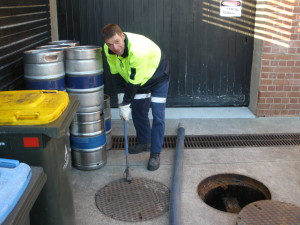
Whether you’re located in metropolitan Adelaide or in a more rural area of SA, if your business has a grease trap then regular cleaning and maintenance (typically four times a year) will help protect your business from flooding and visits from SA Water. You might own a restaurant with a 400 litre to 2400 litre grease trap or you might have a large scale industrial factory with a grease trap with a capacity of several thousands of litres, periodic grease trap pumping is key to effective waste water treatment.
In South Australia, there are thousands of grease traps that help keep the sewer system working well. Did you know that most sewer system malfunctions are a direct result of grease building up and creating a blockage in the system? This is not only an inconvenience for society at large, but a burden on taxpayers’ dollars.
In Adelaide there is up to 9,000 km of sewer pipes and this sewer system carries over 250 megalitres of waste water to water treatment plants on a daily basis. Let’s find out what happens between your business and the waste water treatment plant.
How a Grease Trap Works
When waste water leaves your business, it will enter your grease trap, unless you have express permission from SA Water to not have a grease trap for your business. Once the waste water is inside the concrete or plastic grease trap or grease arrestor pit, the water will settle, allowing for grit and sludge to sink to the bottom while oil and grease collect at the surface.
Some grease traps will have a parallel plate assembly section and also grease trap filters that will further separate the fatty oils from water. Once the water has passed through these stages, it is free to flow into the sewer system.
Where Grease Often Ends Up
The process of grease trap pumping is simple. A professional liquid waste company will come to your premises and will begin pumping the contents into a liquid waste vacuum truck. Grease trap waste truck operators will wash the concrete walls of the grease arrestor pit, once it is empty they will scrape down the sides freeing up all the fatty oils and grease and spray a perfume on the ground to help cover up the foul odours from the grease trap.
An environmentally friendly way of dealing with grease waste is to convert it into garden mulch. This is done by mixing sawdust, wood chips and peat moss into the grease. Given time, the process of decomposition will break down the grease into more basic molecules which can then be used to grow flowers, plants and produce. Agriculture is extremely demanding on soil and nutrients need to be replaced in topsoil in order to be able to grow more vegetation.
By recycling the liquid waste from YOUR grease trap with Nitschke Liquid Waste you will –
- Protect your own sewer system and the sewer system of all of your neighbours from flooding.
- Employ local South Australians.
- Lighten the load on waste water treatment plants.
- Help produce nutrient-rich soil from recycling your grease trap waste product.
- Eliminate bad odours coming from your kitchen or sewer system.



